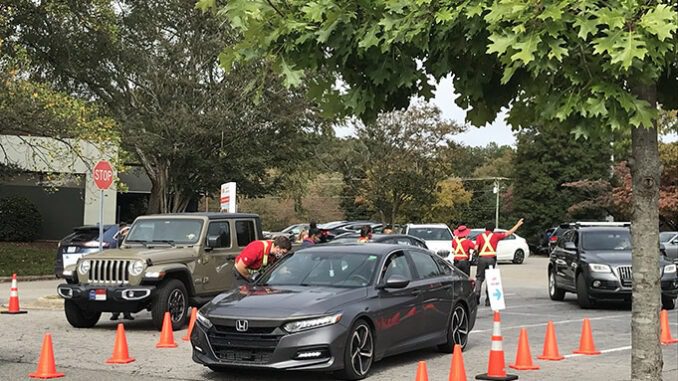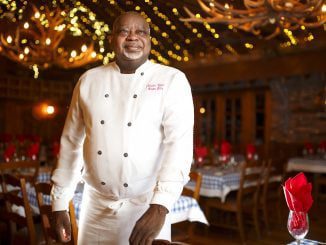
After waiting in a line that stretched nearly a quarter mile to I-440, Kendall pulled her pickup truck into the Lake Boone Shopping Center parking lot.
Within eight seconds, someone was at her window, looking up from her iPad to give her a boisterous greeting.
There were 25 cars ahead of Kendall in the drive-thru line at the Boone Trail Chick-fil-A. Within three and a half minutes, she’d be back on the road, food and drink in hand.
At 22 seconds, the car in front of Kendall moved. So did the woman taking her order, signaling for her to drive and talk.
The six order takers working the line seem to do nothing but walk, often with large vehicles moving uncomfortably close to them. One estimated that they’d log more than two miles walked in the lunch rush hour, back and forth, from car to car, taking orders and payment.
And what a lunch rush it was.
Monday marked the start of David Langston’s final week as owner/operator of the Lake Boone Chick-fil-A, where he’s been since the store opened in late 2015. Langston has been working for the chain since he was 14. Prior to Lake Boone, he owned the Triangle Town Center store. If you remember the viral video of the kid who tried to buy a clip-on tie before his Chick-fil-A interview, Langston was the one that hired him, earning them both an appearance on Good Morning America.
Now, Langston and several key members of his team, will be leaving Lake Boone to operate a store in Brier Creek.
To celebrate the transition, they decided to leave Lake Boone with a bang. Starting at noon on Monday, they set out to break the drive thru traffic record.
“We’re hoping to set the world record of most cars served in an hour, for any drive thru, any concept,” Langston specified. “We’re hoping to break 400 cars, and we’d be the first to do so.”
That would be a car every nine seconds—a daunting challenge, and one that’s evolved over Langston’s time making and serving chicken.
“The majority of our guests that come at lunch time are on their lunch break,” he said. “They need to be able to get in and get out quickly. That became kind of a fun challenge to us, to get better at it every day.”
It would be a stretch. The Lake Boone store record was 357 cars in an hour, set three weeks earlier. Langston also tracks drive-thru traffic in 15-minute increments, and the store record was 96 cars. They’d need to do that four times in a row, and find a way to squeeze in 16 more customers.
Plus, it was cloudy.
“You notice the sun’s not out today,” he said. “That’s normally a deterrent, even if it’s not raining. Honestly, looking at our team and how we’re prepared, the bigger challenge is going to be having 400 cars show up.”
Langston’s team has been busy on social media, encouraging customers to participate in the record quest, and to make use of the online app to order, allowing them to pay online as well, shaving valuable seconds off of their time.
As noon approached, the team began preparing for the rush. Traffic cones extended the drive thru lane through two rows of parking spots. They also closed the dining room to walk-in customers so they could provide extra support to the drive thru.
A total of 14 team members were in the parking lot. One employee directed traffic as cars left the road and pulled into the lot, directing them to one of the two drive thru lanes. Another directed traffic at the other end, making sure they were able to exit without creating congestion. There were six order takers and a floating “coach” each one walking with their customer’s car toward the restaurant until the order was in, then immediately moving back to the end of the line to take the next available customer, passing all of their teammates in the process. It was one-part leapfrog, two-parts ballet, keeping the line, and the employees, in near constant motion.
A traffic director made sure cars successfully navigated the first bottleneck, a brief merge into one lane to turn a corner.
Then the two mobile cash drawers—employees with change belts and pouches stuffed with bills—handled cars that haven’t already paid by app or card. They greeted each driver by name, both out of friendliness and to ensure that everyone knew the order of the cars as they approach the store.
Then, after one more merge and turn, the cars enter the home stretch. They’re greeted by Brandon.
“It’s my first day,” he confessed before spending an hour darting back and forth in the narrow space between cars and the wall of the restaurant.
After greeting them with an energetic, “Welcome! You’re in the game!” Brandon instructed each driver, “Please keep your window all the way down.”
That was because, more often than not, a worker at the drive thru window was already leaning out, bag in one hand, the other hand frantically waving them forward. A sign cautioned drivers to clear out their cup holders. The employees didn’t want anyone to delay the process by not being ready for their food.
The line included police cars, an ambulance and cars with passengers ranging from dogs to babies to soldiers. Several customers clearly knew about the record, wishing the employees walking alongside them luck.
At 12:51, a white truck—not Kendall’s—pulled up to the window. Her bag was already held out to her. A manager poked his head out the window.
“You’re number 400,” he told the driver, as shouts of glee poured out from the kitchen.
Nine minutes later, a manager stepped into the parking lot and climbed on top of a patio table, squinting against the sun, which emerged from behind the clouds at some point in the last hour.
“Chick-fil-A people,” he shouted. “We just served 474 cars in one hour.”
They didn’t just break the record, they obliterated it. One car every 7.5 seconds.
The employees working the line cheered.
“I’m going to celebrate by taking a sip of water,” said one employee.
Then they got back to work. Just because the hour was over didn’t mean the line was. There were more customers to serve. The ballet would continue.


